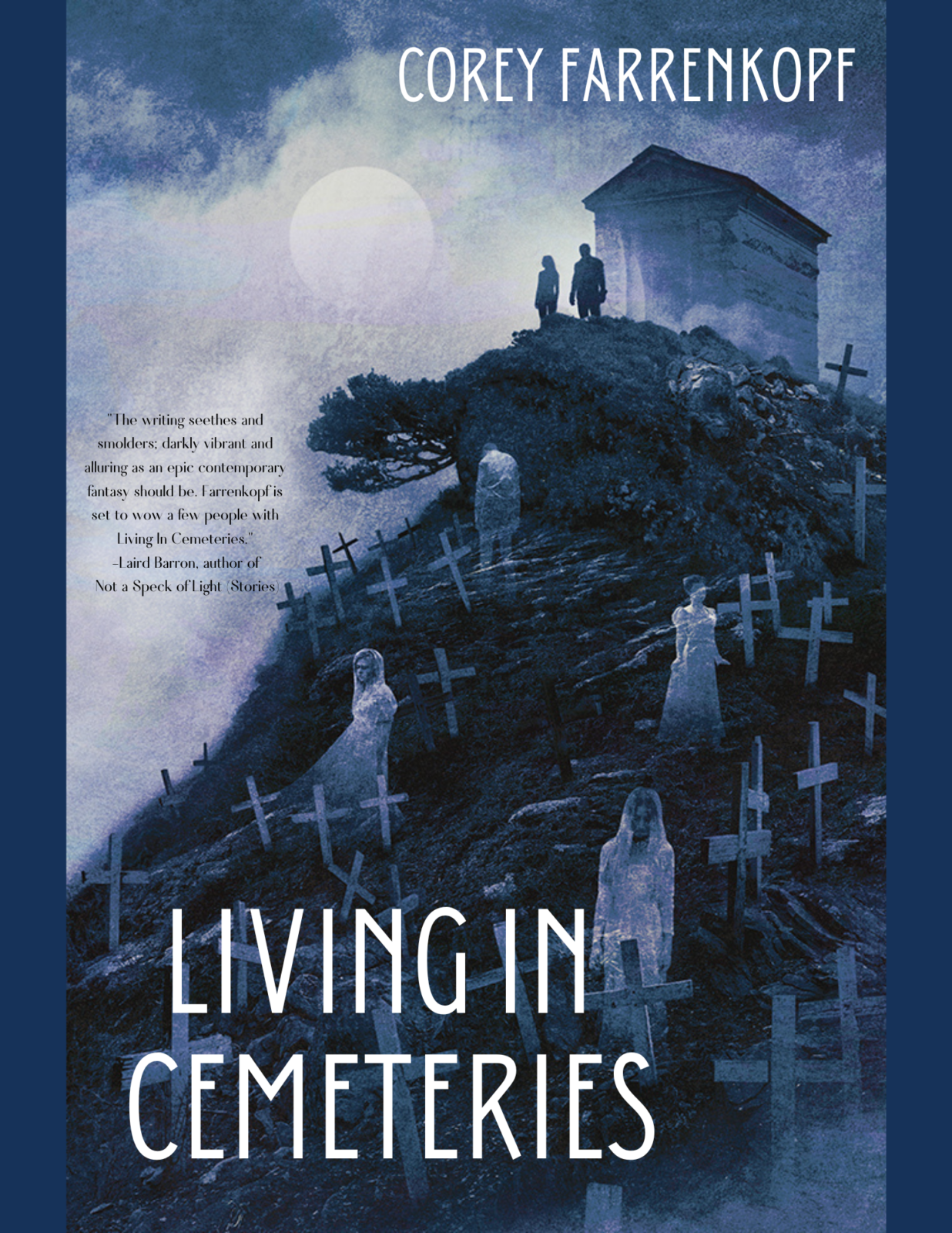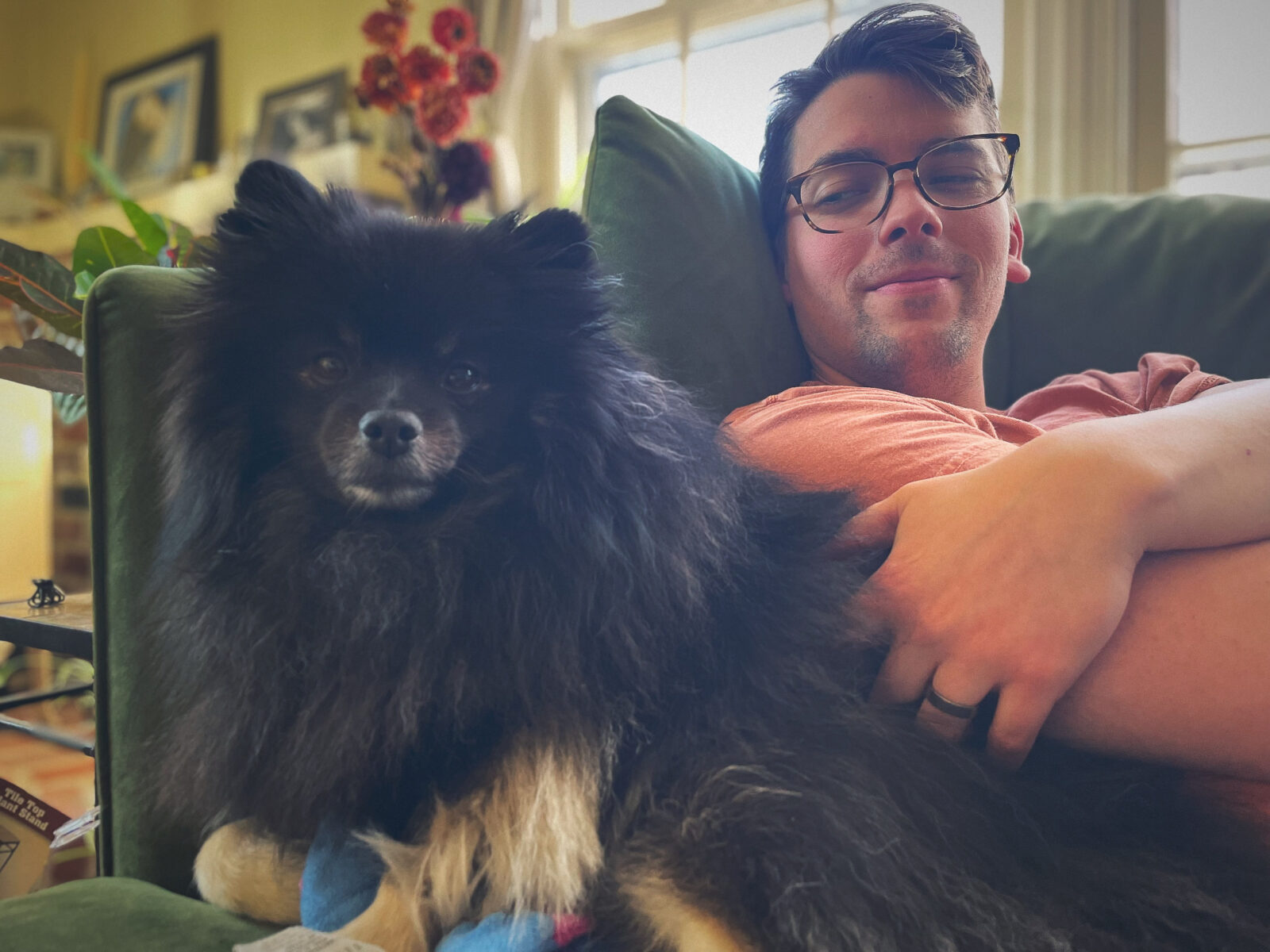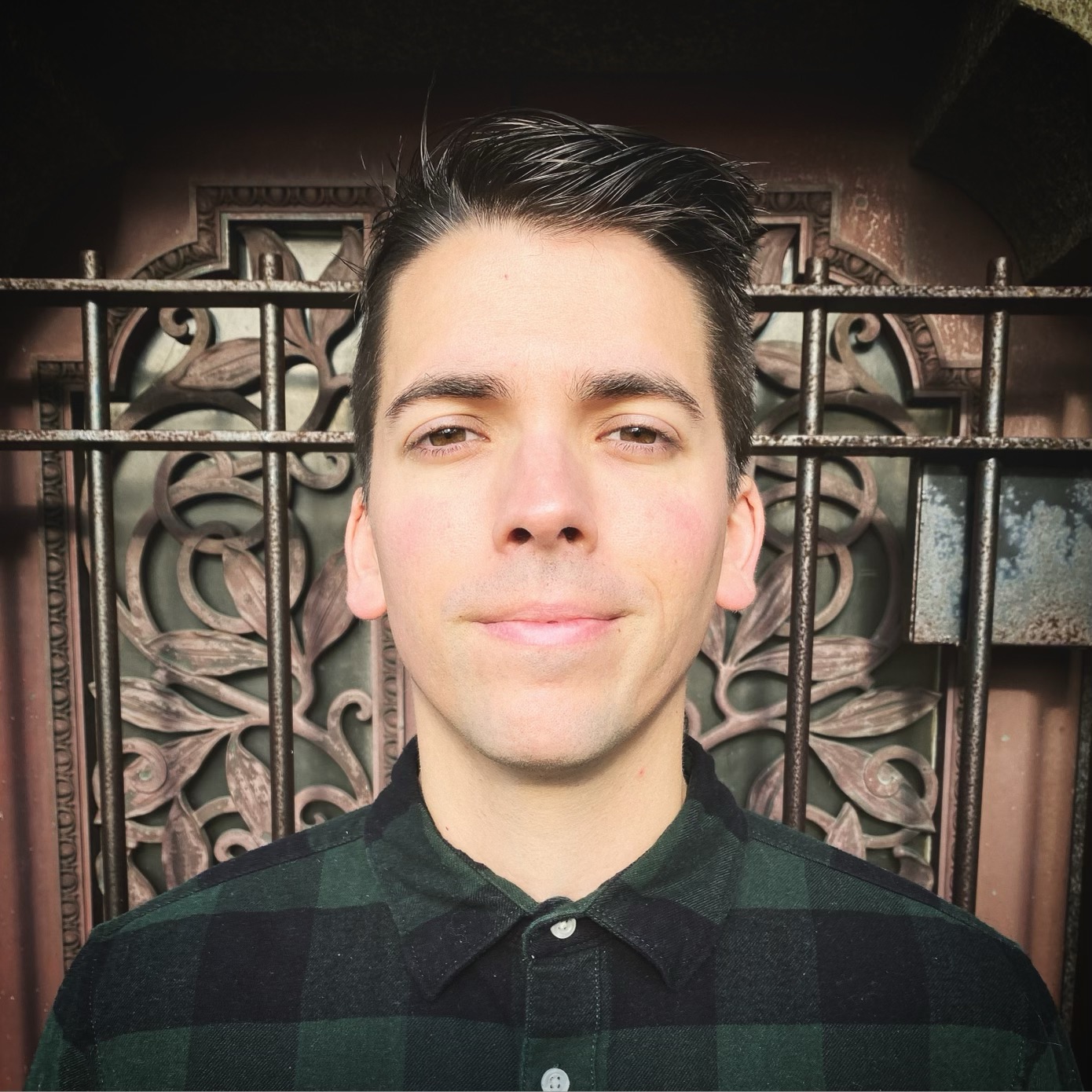Corey Farrenkopf’s writing often combines beautiful, sophisticated composition with downright spooky vibes. His new novel, Living in Cemeteries, has generated a lot of excitement in horror and literary circles. I’ve been a fan for a long time. Huge thanks to Corey for spending time with my questions!
—Myna
***

Cover Artist: Mikio Murakami
Myna Chang: Tell us about your new novel, Living in Cemeteries! What’s it about? Who are the characters? What themes do you explore?
Corey Farrenkopf: This is a fairly complicated novel to break down into an easy elevator pitch…trust me, I’ve tried! There’s a lot going on in here…This is the boiled-down version I’ve been using to explain to anyone who will list:
Dave Gallagher mows the lawns and digs the graves at cemeteries in his hometown on Cape Cod. He also keeps the peace between the ghosts inhabiting those cemeteries. In the world of Living in Cemeteries, wrongdoing is atoned for by a person’s descendants. Spirits decapitate relatives of serial killers and lay pox blankets over men responsible for the Trail of Tears. The only way Dave can learn of his pre-ordained death is by traveling the New England countryside, visiting haunted cemeteries, asking familial ghosts what fate has in store. A gruesome death, or a happily-ever-after with his longtime girlfriend, Jessica? Marauding Spirit-whipped bulls and deadly nightshade, a doomed roommate, and a wayward crypt-sleeper each derail Dave’s path to understanding, but nothing presents more of a challenge than his silent, long-dead father. The man’s refusal to speak leaves Dave wondering what evils his parents committed. How dark is the shade cast by his family tree? The only way to find out is to speak to the dead, but Dave’s not always going to like the answers he receives.
The main themes I’m exploring here are, of course, death (with a title like that), longing, loss, love, what it actually means to be a good person, what actually equals a good life…and botany! (Amongst other things!)
MC: What was your inspiration for the story?
Corey: So, I wrote this right when I graduated from Undergrad at UMASS Amherst. I was a little lost and was really trying to figure out who I wanted to be and what I actually cared about. While I contemplated all of this standard 20-something existential dread, I was mowing the cemeteries in the town I grew up in. So, I’d mow for eight-hour days, listening to my favorite punk bands or audiobooks and daydreaming about the book I’d write that was partially set in the cemeteries I was currently landscaping. A lot of weird things happen in cemeteries, so it was good fodder for the novel. I talk a little more about this in my essay, “Walking in Cemeteries,” over in Nightmare Magazine. You can read it here.
In addition to that, I was raised Roman Catholic and went to Catholic school for nine years, so I’ve always been pretty obsessed with morality, which is at the center of Living in Cemeteries. I’m not religious at all, and there is no religion in this book (for the most part), but I do still think of what factors make a person a “good person” and like the math of our life decisions…as in how many “good” decisions do we need to make in order to be a “good” person…It’s kind of like the main point of the TV show The Good Place. If you haven’t watched that, you definitely need to.
And finally, I’ve seen a lot of ghosts…that helps write a ghost novel 🙂
MC: What’s your writing process like, in general? Did that hold true for this novel?
Corey: These days, I mostly write on my lunch breaks and steal hours where I can when I’m not at work. So, I probably draft between 500-750 words a day. When I was writing Living in Cemeteries, I used to hold myself to a minimum of 1000 words a day. I had seen Aimee Bender give a talk at UMASS, and she said it was a good practice to get in for young writers to set a word goal and to get in the habit…so that’s what I did. Sometimes, I will write novels and short stories all the way through without editing. Others I edit as I go. I think I got that idea from Kelly Link. I believe she said in an interview that she always edits everything she wrote the day before before drafting new stuff…it gets you in the right headspace/flow to continue. (Sorry if it wasn’t Kelly Link who said that….) So, some of my work feels better doing that, some of it doesn’t. Living in Cemeteries was not plotted, and I wrote it straight to the end…but it went through so many edits and revisions that plotting it might have been a good idea from the start.
But basically, every larger project I work on ends up having a different process. Sometimes it’s close to the way I wrote the last one, sometimes it’s completely different. I kind of wish it was always the same, so I’d know what I’m getting into, but alas that is not the case.
MC: What was the publishing process like for you?
Corey: It was a long one! First off, this was the novel that landed me my agent, Marie Lamba of the Jennifer De Chiara Literary Agency. I queried her out of the blue and she loved the book, so she signed me, which was probably about seven years ago. When the book first went out on submission, we received a lot of good feedback but not bites. At the time, Horror/Dark Fantasy wasn’t as on the rise as it is now, so that might have played a factor in it. That or the fact that Living in Cemeteries, like the majority of my work, sits very strangely between genres that editors don’t always know how they’re going to market. I can’t tell you the number of times I heard something along the lines of, “It’s too literary to be considered genre fiction,” or “There’s too many genre elements to be considered literary.” (I think a lot of this also has to do with my pacing…but also, I’m not a believer of thinking like this. Most of my favorite authors walk this genre line, so it can totally be done!). So, after we didn’t get any offers, we sent another novel out and shelved Living in Cemeteries until a number of months ago when Marie emailed me saying she thought it would be a good time to send LiC back out again, given the publishing climate surrounding this genre has changed a bit. And we got three offers on it, so it went to auction, and JournalStone ended up publishing LiC on April 19th, 2024. So, in total, this book was written and rewritten and edited and re-edited and subbed and resubbed over the course of about six and a half years before it found the right home, so don’t give up on any of those strange, in-between-genre novels you’ve had a hard time placing! Your time might still come 🙂
MC: I’ve been a fan of your short fiction for years. Will you continue to write short stories, or has your focus shifted to longer works?
Corey: I love short stories, so there’s no way I’m going to stop writing them to focus solely on novels. My usual strategy is to write a few short stories in between every longer project. It’s like a little reward for myself. I have a handful of markets I put on a list each year on New Year’s Eve and try to write stories for them. My dream market resolutions! Like this year, I’ll have a story in The Deadlands and one in Weird Horror, both of which were on the list this year! It’s a fun game, but it also gives me a lot of motivation to stay constant with my short stories.
I’ve got one finished collection called Haunted Ecologies that I’m working on with my agent at the moment and a second collection that’s basically done once I find a home for a few more of the stories. I like the idea of being an author who puts out semi-regular collections once the first one gets picked up. Fingers crossed on that, anyway. Most of my favorite authors are like this or have more collections than novels, so it’s always something I think about with my own career trajectory.
MC: One of the things I love about your writing is the way you bridge literary fiction and speculative stories. Does your approach differ depending on where you plan to submit a story? How do you conceptualize a new story—with character, plot, voice, something else?
Corey: My approach definitely shifts a little depending on where I hope to send a story. As I mentioned above, I have a yearly list I try to place stuff with, and that list changes every year based on acceptances from the previous year. So, when I’m writing a story specifically for one of them, like Apex, I’m going to read a number of their stories and see what their vibe is and then see what a Corey story would look like with a similar vibe (and then cross my fingers and hope they pull it out of the slush). But I also just write random stories without a home in mind, and those become whatever they feel like becoming.
Most of my stories start with an image or a place. Very rarely do I get a strong sense of a character upfront. That usually shows up later once I’ve explored the world or the image a bit. Voice is also usually there from the get-go. If I don’t have the voice and it isn’t feeling the way I want it to feel, the story doesn’t work. I’ve found I can’t really go back and rework the voice once the story is written. I have a few stories that will probably never see the light of day because the voice was so off and couldn’t get rerouted.
MC: I’d like to ask about your Uncharted story, “Spring Fed.” Such a chilling tale! How did that piece come about?
Corey: That’s one of my favorite stories! Yeah, so my father built a cabin in Maine a number of years ago that we would visit. In the woods behind this house is a freshwater spring that is always replenishing itself, so, being who I am, my mind was like, what sort of weird story can I set in the woods by this spring, and that’s how we got Spring Fed. I have a number of stories where I envision the forest as an old god in a cosmic horror sense, and these gods are trying to gain some form of sustenance or worship from humans. This story is more about the sustenance than the worship. Spring Fed is probably the cornerstone of that little mythos I’ve been messing with…along with a novelette that’s going to be in my debut collection. I’m so glad you liked it!
MC: Are there any authors or stories that have had a significant impact on your writing?
Corey: Oh, definitely. With Living in Cemeteries, I was just starting to get my education in genre fiction, so my early influences tend to be authors more commonly placed in the “literary” sphere, but that’s not exclusive. So, early influences: Karen Russell, Kelly Link, Aimee Bender, George Saunders, Haruki Murakami, David Mitchell, Neil Gaiman, M. Rickert, and Nathan Ballingrud. Those last few drift more into the “genre” sphere than the others, maybe…
But today the authors who are my guiding light are all those above (specifically Russell, Link, and Ballingrud) plus Jeff VanderMeer, Paul Tremblay, A.C. Wise, Sarah Pinsker, Laird Barron, Brian Evenson, Kay Chronister, Tamsyn Muir, Stephen Graham Jones, Jeffrey Ford, Gordon B. White, and I’m sure I’m forgetting a bunch of others, but those are the main ones that pop into my head right now.
MC: Even though I’ve never been to your library in person, I look forward to your Saturday at the library videos. How did this series get started? How do you choose the books you will feature?
Corey: Well, I love to highlight what we have on the shelves at our library, so this felt like a natural way to do that (always trying to get people to read weird genre stuff!). For my recommendation videos, I usually pull new releases before they come out, or I search our new shelf for stuff I’m excited about. That way, I’m also providing a service to our local patrons by helping them find their next favorite read. Then there are the photos I post on Instagram that are just me in some random part of the library. I think it will be cool someday to look back on all of them and see how I’ve aged through the years, Saturday to Saturday!
MC: What do you read for fun?
Weird short stories. Dark Fantasy short stories. All those between-genres short stories 🙂

MC: Do you have pets or other non-writing hobbies? Tell us about it!
Corey: Haha, yeah, I have a little Pomeranian named Ooli! He’s the best. I also garden and bird watch and play music, but I don’t manage to do any of those things as much as I’d like to. I’m always telling myself I need to get in another punk band or something, but I have no idea where I’d find the time…
MC: What’s next for you?
Corey: That’s also a good question! As I said above, I have a short story collection (environmental horror) that’s finished, so hopefully, we’ll find a good home for that soon. I have another collection waiting in the wings. I have an environmental cosmic horror novel that will hopefully find a home soon, too. I’m editing two different new novels at the moment; one’s a cosmic horror/cursed island novel that I’m telling myself is kind of a combination of Jeff VanderMeer’s Annihilation, R.F. Kuang’s Yellowface, and Thomas Olde Heuvelt’s Hex. And the other one is a fragmentary dark sci-fi novel that’s got a Jaws meets Blackfish City meets How High We Go In The Dark vibe going on. So that’s all swirling around at the moment. I don’t know which of them you’ll see out in the world first, but hopefully, you’ll be excited for whichever one shows up.
***
COREY FARRENKOPF lives on Cape Cod with his wife, Gabrielle, and works as a librarian. His work has been published in/is forthcoming from Nightmare, The Deadlands, Vastarien, Three-Lobed Burning Eye, SmokeLong Quarterly, Bourbon Penn, Flash Fiction Online, and elsewhere. His debut novel, Living in Cemeteries, was published by JournalStone in April of 2024! To learn more, follow him on Twitter @CoreyFarrenkopf or on the web at CoreyFarrenkopf.com
Instagram: @Farrenkopf451
TikTok: @CoreyFarrenkopf
Purchase Living In Cemeteries:
From the JournalStone
From local Indie Sea Howl Books
From Barnes and Noble
Photography: Gabrielle Griffis
***
MYNA CHANG (she/her) is the author of The Potential of Radio and Rain (CutBank Books, 2023). Her writing has been selected for the Locus Recommended Reading List, W.W. Norton’s Flash Fiction America, Best Small Fictions, and Best Microfiction. She has won the Lascaux Prize in Creative Nonfiction and the New Millennium Award in Flash Fiction. She hosts the Electric Sheep speculative fiction reading series. Find her at MynaChang.com, and on Twitter & Bluesky at @MynaChang.
